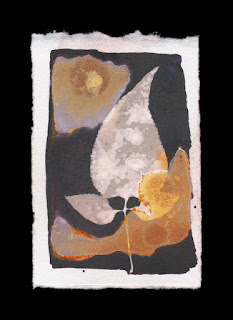 |
| 6 hour exposure of dichromate test print |
So, I made a small salt print (the normal way, with 3% kosher salt), then added a drop of 5% ammonium dichromate to the top left and a drop of 5% potassium dichromate to the bottom right. In the middle of the print, I sprinkled the cream of tartar. Cream of tartar is chemically potassium bitartrate (KC4H5O6), which is a form of tartaric acid.
Again, my discussions with Johannes suggested that adding tartaric acid to a salt print should produce some variations of color. In the future, I'll test this further by mixing up a tartaric acid solution, probably just cream of tartar in water. Then I'll coat that solution onto a salted paper, in addition to regular sodium chloride.
 Just to add some variety, I put a Red Nightshade leaf onto the salted, dichromated and tartarated paper. Then I exposed the paper for about 6 hours in sunlight, from dawn till around noon. Once I'd scanned the image after the first exposure, I let it sit out in sunlight (without the leaf) for another 2 days before I scanned it again. I've continued to leave it unprotected, so I'll be scanning again in a few weeks.
Just to add some variety, I put a Red Nightshade leaf onto the salted, dichromated and tartarated paper. Then I exposed the paper for about 6 hours in sunlight, from dawn till around noon. Once I'd scanned the image after the first exposure, I let it sit out in sunlight (without the leaf) for another 2 days before I scanned it again. I've continued to leave it unprotected, so I'll be scanning again in a few weeks.After 2 hours, the red color in the dichromate was lovely. Unfortunately, after the two days of sunlight, the dichromate had turned mostly violet, while the silver was the expected green. The cream of tartar had left slightly darker spots, but I'm not sure if that's just because it affected the original 6-hour exposure, or if it chemically created a reaction. Further testing is required!
I also did some tests on Potassium Iodide and Potassium Chloride salt prints. I'll have those results up on Flickr in the near future. They haven't been washed and fixed, yet. That's on the agenda for today, though!
No comments:
Post a Comment